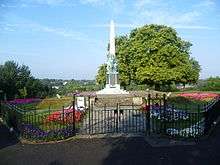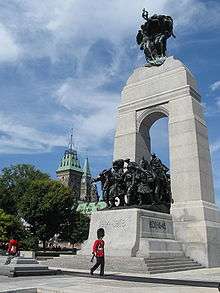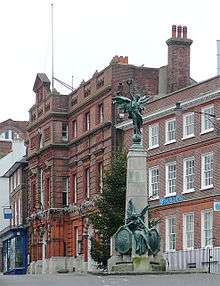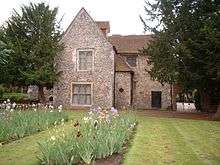Sydney March
| Sydney March | |
|---|---|
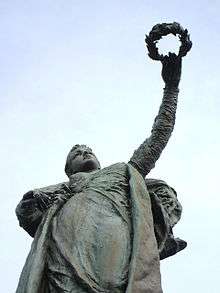 Royal Inniskilling Fusiliers South African War Memorial | |
| Born |
1876 Stoneferry, Kingston upon Hull, East Riding of Yorkshire, England |
| Died |
1968, Second quarter Kent, England |
| Nationality | British |
| Education | Royal Academy Schools |
| Known for | Sculpture |
| Notable work |
"Mafeking 1900" "King Edward VII" "Cecil John Rhodes" Bromley War Memorial National War Memorial of Canada |
| Awards | First Prize, Silver Medal, 1900, Royal Academy Schools |
English sculptor Sydney March (1876–1968) was a prolific artist, whose primary focus was portrait busts and other sculptures of British royalty and contemporary figures, as well as war memorials. One of eight artists in his family, he and his siblings completed the National War Memorial of Canada after the death of their brother Vernon March in 1930.
Background
Sydney March, son of George Henry March and his wife Elizabeth Blenkin,[1] was born in 1876 in Stoneferry, a suburb of Kingston upon Hull, in the East Riding of Yorkshire, England.[2][3] At the time of the 1891 census, Sydney worked as a monumental sculptor's apprentice. His father was a seed crusher foreman (oil miller).[3][4] By 1901, the family had moved to Battersea, London, where his father was employed as a builder's clerk. Sydney studied at the Royal Academy Schools.[5][6] He was the second of nine children, eight of whom became artists. Three of the March children became sculptors, Sydney, Elsie, and Vernon.[6] The other five artists were Edward, Percival, Frederick, Dudley, and Walter. The ninth sibling was a sister, Eva. Their parents died in 1904.[7][8]
By 1911, all nine siblings, as yet unmarried, were living together in the 17-room house "Goddendene" in Farnborough, Kent, England.[9] Only two of the March siblings ever married, and between them produced three children. Eva married Charles Francis Newman in 1916.[10][11] They had a daughter, Heather.[12] Sydney's brother Frederick married Agnes Annie Gow in 1926.[13] They had two children, Elizabeth and Cecil.[14][15]
Career
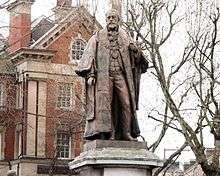
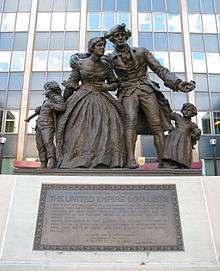
Sydney and his siblings established studios at the family home of Goddendene in Locksbottom, Farnborough after 1901.[5][6] The seven acre grounds had not only three large studios, but also a metal foundry. The studio walls could be slid back, such that the artists could work in natural daylight. The walls of the studios were sufficiently tall that parachutes could be hung to dry during the war.[16]
In 1900, the Royal Academy Schools awarded Sydney first prize, a silver medal, for a model of a statue or group.[6] Between 1906 and 1932, Sydney March exhibited thirteen times at The Exhibition of the Royal Academy of Arts. He exhibited a total of seventeen works at the Royal Academy, primarily portrait busts, statuettes, and equestrian statues.[6]
In addition to casting works at the family foundry, Sydney also had his work cast by the silversmith and bronze foundry of Elkington & Co.[17] One of Sydney's first commissions was a bust of Edward VII, after which the British Royal Family visited the family home of Goddendene.[6] Some of his works included:
- Coronation portrait bust, "King Edward VII" (1841–1910), 1901, for Windsor Castle, in the National Portrait Gallery in London since 1924.[6][18]
- Bronze portrait bust of "Cecil John Rhodes" (1853–1902), South African imperialist and statesman, 1901, in the National Portrait Gallery since 1960.[19]
- Monument to Colonel Samuel Bourne Bevington, philanthropist, first mayor of Bermondsey, bronze statue in mayoral robes on stone base, erected 1910, on Tooley Street in London.[20][21] Listed as a Grade II structure on the National Heritage List for England on 27 September 1972 and amended on 17 September 1998.[20][22]
- Equestrian statue of Lord Kitchener, Commander in Chief of the Indian Army, 1914, in Calcutta.[17][23]
- Bronze bust of Field Marshal Sir John French, 1st Earl of Ypres (1857–1925), commander of the British Expeditionary Force from August 1914 to December 1915, produced during WWI.[17]
- Equestrian statue of Lord Kitchener, Kitchener Barracks on Khartoum Road in Chatham. Added to the National Heritage List for England on 24 May 1971. Amended 21 November 1996. Listed as a Grade II structure.[16][24][25]
- Bromley Parish Church Memorial, to commemorate the parishioners who died in World War I, 1921, at Saint Peter and Saint Paul Church on Church Road in Bromley, Kent.[26][27]
- Bromley War Memorial, square obelisk constructed of Portland stone with three bronze figures which represent Liberty, Victory, and Peace. Victory in the center, winged and holding a laurel wreath. Flanked by Liberty, with a torch, and Peace, with flowers of remembrance. At Martin's Hill on Glassmill Lane in Bromley, Kent. Erected 1922. Listed as a Grade II structure on the National Heritage List for England on 14 December 1995.[28][29][30]
- United Empire Loyalist Monument, unveiled on Empire Day 23 May 1929, at Prince's Square on Main Street East in Hamilton, Ontario. Gift to the city of Hamilton from Stanley Mills.[31] The basis of a commemorative plate issued in 1932.[32] Also the basis of a stamp issued on Dominion Day, 1 July 1934.[33] Unveiled for the second time on 25 June 1958 by Governor General Vincent Massey.[34] Depicts a family of Loyalists just after drawing their lot number from the surveyor.[34]
- Lancaster Monument at East Sheen Cemetery on Sheen Road in Richmond, Surrey, England. Marks the graves of George William Lancaster (died 1920) and Louisa Mary Lancaster (died 1922). Constructed of Portland stone and bronze. Listed as a Grade II* structure on the National Heritage List for England on 5 March 1992.[35] Described by Hugh Meller, author of London Cemeteries: An Illustrated Guide & Gazetteer, as "arguably the most dramatic sculpture in any of London's cemeteries."[36] The title of the piece is "The Angel of Death".
National War Memorial of Canada
It was not unusual for the March siblings to collaborate on their art pieces. The best known example of this is The Response, the National War Memorial of Canada in Ottawa, Ontario. Sydney's brother Vernon, after a world-wide competition in 1925, was one of seven finalists out of a field of 127 entrants. The seven finalists then submitted scale models of their proposed designs.[37] Vernon was awarded the commission in January 1926.[6][38] His design included bronze figures of Victory and Liberty on top of a granite arch. Below the arch, at the rear, is an unlimbered cannon. The monument includes 22 bronze figures under the arch, representing the branches of the Canadian forces that existed during World War I.[39]
Vernon March died of pneumonia in 1930, before the monument had been completed.[6][37] With his sister Elsie March and four of his brothers, Sydney completed the bronze figures for the monument by July 1932. However, as the site in Canada had not yet been prepared, construction of the arch in Ottawa was delayed. Instead, the bronze figures were mounted on a base and displayed at Hyde Park in London for six months. Later, they were stored at the family studios at Goddendene. In 1937, the bronzes were shipped to Ottawa.[38] After construction of the arch and preparation of the surrounding area, the National War Memorial of Canada was unveiled by King George VI on 21 May 1939. It commemorates the Canadian response in WWI.[38]
Bronze figures of the National War Memorial

 Soldiers
Soldiers Rear
Rear Side
Side
Other collaborative works

One of the first major pieces on which the March family collaborated was the Royal Inniskilling Fusiliers South African War Memorial. While Sydney was the primary sculptor, all of the March artists participated in the creation of the monument that was dedicated to the Inniskilling Fusiliers who died in the Boer War (1899–1902). The family erected it themselves in Northern Ireland in 1902.[40] It was initially positioned on High Street in Omagh, County Tyrone, where it was unveiled by the Duchess of Abercorn on 25 November 1904. However, it was considered a traffic hazard and relocated to Drumragh Avenue in Omagh in February 1964.[41][42]
Other art pieces on which the March family collaborated include the Lewes War Memorial at School Hill on High Street in Lewes, East Sussex, England. Sydney's brother Vernon was the primary sculptor.[43][44] The war memorial features a central obelisk of Portland stone upon which an angel representing Victory is perched, her arms raised, one hand holding a laurel wreath. Other bronze angels sit at the base of the monument; adjacent shields list the names of the deceased soldiers of World War I.[43][44] The Lewes War Memorial was unveiled in 1922. It was rededicated in 1981 to include the deceased of World War II. It is also on the National Heritage List for England.[43][44]
There is also a war memorial at Sydenham, London, England, dedicated to the fallen soldiers of World War I and II who were employees of the south suburban gas works.[45] The monument includes a bronze figure of Victory standing on a globe, with serpents at her feet. In addition, bronze plaques listed the names of the deceased soldiers, as well as those from the gas company who served.[45] Sydney March was the primary sculptor for the Livesey Hall War Memorial, also referred to as the Sydenham War Memorial, which was unveiled by Lord Robert Cecil on 4 June 1920. It is on the National Heritage List for England.[45] In October 2011, the three bronze plaques from the front of the memorial were stolen.[46]
Death
Sydney March died at age 92 in the second quarter of 1968 in the county of Kent, England.[47] Most of the members of the March family, including parents George and Elizabeth, are interred at Saint Giles the Abbot Churchyard in Farnborough, Kent, England. Sydney's ashes were buried in the family plot on 22 June 1968.[48] In 1922, Sydney sculpted the bronze angel that marks the family graves.[6] His last surviving sibling Elsie March died in 1974.[49]
Legacy

In April 2011, the Chelsfield Village Voice, the monthly newsletter for the village of Chelsfield in the London Borough of Bromley, described the substance of a talk that local historian and author Paul Rason gave the previous month to the area historical society. The topic was the March family of artists. The lecture was accompanied by photographs, including one of Sydney's equestrian statue of Lord Kitchener during construction. There were photographs of the March family home of Goddendene in Locksbottom, Farnborough. The lecture also included images of the bronze figures of the National War Memorial of Canada. In addition, in 2011, an exhibition was held at the Bromley Museum at The Priory on Church Hill in Orpington, in the London Borough of Bromley. The exhibition, which featured the work of local artists, included scale models created by members of the March family.[16] Also, a black and white, silent movie filmed in 1924 reveals the March artists at work in their studios at Goddendene, and has been reproduced by British Pathé.[50] In addition, the National War Memorial of Canada has been the location for Canada's annual National Remembrance Day celebration since 1939, with the only exception being those times when construction near the site precluded it. During those few years, the ceremony was held instead on Parliament Hill in Ottawa.[39] The original model for the National War Memorial is displayed in the Royal Canadian Legion Hall of Honour in the Canadian War Museum in Ottawa (pictured).
References
- ↑ March, George Henry. "England & Wales, FreeBMD Marriage Index: 1837–1915". ancestry.com. England and Wales Civil Registration Indexes. General Register Office (as re-printed on Ancestry.com).
- ↑ March, Sydney. "England & Wales, FreeBMD Birth Index, 1837–1915". ancestry.com. England and Wales Civil Registration Indexes. General Register Office (as re-printed on Ancestry.com).
- 1 2 March, Sidney. "1891 England Census". ancestry.com. Census Returns of England and Wales, 1891. The National Archives of the UK (as re-printed on Ancestry.com).
- ↑ March, George H. "1881 England Census". ancestry.com. Census Returns of England and Wales, 1881. The National Archives of the UK (as re-printed on Ancestry.com).
- 1 2 March, Sydney. "1901 England Census". ancestry.com. Census Returns of England and Wales, 1901. The National Archives, 1901 (as re-printed on Ancestry.com).
- 1 2 3 4 5 6 7 8 9 10 March, Sydney. "Mapping the Practice and Profession of Sculpture in Britain & Ireland 1851–1951". sculpture.gla.ac.uk. University of Glasgow History of Art and HATII. Retrieved 30 March 2012.
- ↑ March, George Henry. "England & Wales, FreeBMD Death Index: 1837–1915". ancestry.com. England and Wales Civil Registration Indexes. General Register Office (as re-printed on Ancestry.com).
- ↑ March, Elizabeth. "England & Wales, FreeBMD Death Index: 1837–1915". ancestry.com. England and Wales Civil Registration Indexes. General Register Office (as re-printed on Ancestry.com).
- ↑ March, Sydney. "1911 England Census". ancestry.com. Census Returns of England and Wales, 1911. The National Archives of the UK, 1911 (as re-printed on Ancestry.com).
- ↑ March, Eva B. "England & Wales, Marriage Index: 1916–2005". ancestry.com. England and Wales Civil Registration Indexes. General Register Office (as re-printed on Ancestry.com).
- ↑ Newman, Charles F. "England & Wales, Marriage Index: 1916–2005". ancestry.com. England and Wales Civil Registration Indexes. General Register Office (as re-printed on Ancestry.com).
- ↑ Newman, Heather. "England & Wales, Birth Index: 1916–2005". ancestry.com. England and Wales Civil Registration Indexes. General Register Office (as re-printed on Ancestry.com).
- ↑ March, Frederic H. "England & Wales, Marriage Index: 1916–2005". ancestry.com. England and Wales Civil Registration Indexes. General Register Office (as re-printed on Ancestry.com).
- ↑ March, Elizabeth E. "England & Wales, Birth Index: 1916–2005". ancestry.com. England and Wales Civil Registration Indexes. General Register Office (as re-printed on Ancestry.com).
- ↑ March, Cecil G. "England & Wales, Birth Index: 1916–2005". ancestry.com. England and Wales Civil Registration Indexes. General Register Office (as re-printed on Ancestry.com).
- 1 2 3 "Local History Group" (PDF). chelsfieldevents.co.uk. Chelsfield Village Voice. April 2011. pp. 3–4. Retrieved 30 March 2012.
- 1 2 3 "Early 20th Century Bronze Bust of Field Marshal Sir John French, 1st Earl of Ypres, by Sydney March, signed". armoury.co.uk. The Armoury of St. James's. Retrieved 30 March 2012.
- ↑ "King Edward VII". npg.org.uk. National Portrait Gallery. Retrieved 1 April 2012.
- ↑ "Cecil John Rhodes". npg.org.uk. National Portrait Gallery. Retrieved 1 April 2012.
- 1 2 Historic England. "Statue on Island Site in Front of South London College and Railings (1385976)". National Heritage List for England. Retrieved 9 April 2012.
- ↑ Clarke, Edward T. "Bermondsey, its historic memories and associations". ebooksread.com. eBooksRead.com. p. 20. Retrieved 1 April 2012.
- ↑ Historic England. "Details from image database (471396)". Images of England. Retrieved 1 April 2012.
- ↑ "Lord Kitchener – Proposed Statue in Calcutta". The Age. Melbourne, Australia. 16 September 1909. Retrieved 1 April 2012.
- ↑ Historic England. "Statue of Lord Kitchener Approximately 50 Metres West of Entrance to Kitchener Barracks (1268230)". National Heritage List for England. Retrieved 9 April 2012.
- ↑ "Statue of Lord Kitchener Approximately 50 Metres West of Entrance to Kitchener Barracks, Chatham". britishlistedbuildings.co.uk. British Listed Buildings. Retrieved 9 April 2012.
- ↑ "Bromley Parish Church Memorial". bromley.gov.uk. London Borough of Bromley. Retrieved 1 April 2012.
- ↑ "Bromley Parish Church Memorial". bromley.gov.uk. War Memorials in Bromley. p. 6. Retrieved 9 April 2012.
- ↑ Historic England. "Bromley War Memorial, St Martin's Hill (1116976)". National Heritage List for England. Retrieved 31 March 2012.
- ↑ "Bromley War Memorial, St Martin's Hill, Bromley". britishlistedbuildings.co.uk. British Listed Buildings. Retrieved 31 March 2012.
- ↑ "Bromley War Memorial". bromley.gov.uk. War Memorials in Bromley. p. 7. Retrieved 31 March 2012.
- ↑ "Loyalist Monuments – Hamilton UEL Monument". uelac.org. United Empire Loyalists' Association of Canada. Retrieved 1 April 2012.
- ↑ Colin Mills, UE. "Loyalist Plates". uelac.org. United Empire Loyalists' Association of Canada. Retrieved 4 April 2012.
- ↑ "The United Empire Loyalist Stamp – 1934". uelac.org. Sir Guy Carleton Branch, United Empire Loyalists' Association of Canada. Retrieved 4 April 2012.
- 1 2 "United Empire Loyalist Statue". myhamilton.ca. myHamilton.ca. Retrieved 4 April 2012.
- ↑ Historic England. "The Lancaster Monument, East Sheen Cemetery (1239967)". National Heritage List for England. Retrieved 4 April 2012.
- ↑ "The Lancaster Monument, East Sheen Cemetery, Richmond". britishlistedbuildings.co.uk. British Listed Buildings. Retrieved 1 April 2012.
- 1 2 Baker, Eamonn (15 July 2008). "Memorial to a celebrated sculptor". Derry Journal. Retrieved 1 April 2012.
- 1 2 3 "The Response". veterans.gc.ca. Veterans Affairs Canada. Retrieved 4 April 2012.
- 1 2 "Our Military Heritage – The National War Memorial". legion.ca. The Royal Canadian Legion. Archived from the original on 4 September 2007. Retrieved 29 March 2012.
- ↑ "Nine Artists In One Family". The Sydney Mail. 17 February 1909. p. 12. Retrieved 4 April 2012.
- ↑ "The Royal Inniskilling Fusiliers South African War Memorial". omagh.gov.uk. Omagh District Council. Retrieved 1 April 2012.
- ↑ "War Memorials – The design and placing of memorials". historyfromheadstones.com. History from Headstones. Retrieved 4 April 2012.
- 1 2 3 "Object Details – War Memorial". publicsculpturesofsussex.co.uk. Public Sculptures of Sussex, hosted by Cultural Informatics Research Group, University of Brighton. Retrieved 4 April 2012.
- 1 2 3 Historic England. "War Memorial (1191738)". National Heritage List for England. Retrieved 9 April 2012.
- 1 2 3 Historic England. "Livesey Hall War Memorial (1253111)". National Heritage List for England. Retrieved 9 April 2012.
- ↑ "Sydenham, South Suburban Gas Works WW1 and WW2 War Memorial". lewishamwarmemorials.wikidot.com. Lewisham War Memorials by Local History and Archives Centre, Lewisham Library. Retrieved 4 April 2012.
- ↑ March, Sydney. "England & Wales, Death Index: 1916–2005". ancestry.com. England and Wales Civil Registration Indexes. General Register Office (as re-printed on Ancestry.com).
- ↑ "Burial and Cremation Records". farnborough-kent-parish.org. St. Giles the Abbot, Farnborough (Kent). Retrieved 1 April 2012.
- ↑ March, Elsie. "England & Wales, Death Index: 1916–2005". ancestry.com. England and Wales Civil Registration Indexes. General Register Office (as re-printed on Ancestry.com).
- ↑ "Sister And Seven Brothers". britishpathe.com. British Pathé. 1924. Retrieved 4 April 2012.
External links
- National Portrait Gallery – King Edward VII Photograph of "King Edward VII"
- National Portrait Gallery – Cecil John Rhodes Photograph of "Cecil John Rhodes"
- The Armoury of St. James's Photograph of bust of Field Marshal Sir John French
- Sydenham, South Suburban Gas Works WW1 and WW2 War Memorial Photograph of Sydenham War Memorial
- The Victorian Web – Sculpture – Sydney March Photograph of Lancaster Monument
- British Pathé – Sister and Seven Brothers, 1924 Movie of Sydney March and his seven siblings
